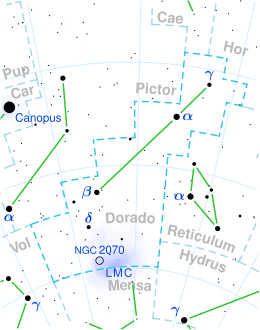Astronomy:Pi2 Doradus
| Observation data Epoch J2000.0 Equinox (celestial coordinates) | |
|---|---|
| Constellation | Dorado |
| Right ascension | 06h 25m 28.63069s[1] |
| Declination | −69° 42′ 25.0800″[1] |
| Apparent magnitude (V) | 5.38[2] |
| Characteristics | |
| Evolutionary stage | horizontal branch[3] |
| Spectral type | G8 III[4] |
| U−B color index | +0.67[2] |
| B−V color index | +0.97[2] |
| Astrometry | |
| Radial velocity (Rv) | 9.1±2.8[5] km/s |
| Proper motion (μ) | RA: −12.184[1] mas/yr Dec.: +200.786[1] mas/yr |
| Parallax (π) | 11.7563 ± 0.058[1] mas |
| Distance | 277 ± 1 ly (85.1 ± 0.4 pc) |
| Absolute magnitude (MV) | +0.78[6] |
| Details[7] | |
| Mass | 1.80±0.07 M☉ |
| Radius | 9.84±0.16 R☉ |
| Luminosity | 51.1±1.1 L☉ |
| Surface gravity (log g) | 2.66±0.08 cgs |
| Temperature | 4,919±29 K |
| Metallicity [Fe/H] | −0.26±0.03 dex |
| Rotational velocity (v sin i) | <2.0[8] km/s |
| Age | 1.61±0.15[9] Gyr |
| Other designations | |
| Database references | |
| SIMBAD | data |
Pi2 Doradus, Latinized from π2 Doradus, is a solitary star[11] located in the southern constellation Doradus. It is faintly visible to the naked eye as a yellow-hued point of light with an apparent magnitude of 5.38.[2] The object is located relatively close at a distance of 277 light-years based on Gaia DR3 parallax measurements, but it is receding with a heliocentric radial velocity of approximately 9.1 km/s.[5] At its current distance, Pi2 Doradus' brightness is diminished by 0.27 magnitudes due to interstellar extinction[12] and it has an absolute magnitude of +0.78.[6]
Pi2 Doradus has a stellar classification of G8 III,[4] indicating that it is an evolved G-type giant star. It is a red clump star that is currently on the horizontal branch—fusing helium at its stellar core.[3] It has 1.8 times the mass of the Sun[7] but, at the age of 1.61 billion years,[9] it has expanded to 9.84 times the radius of the Sun.[7] It radiates 51.1 times the luminosity of the Sun from its photosphere at an effective temperature of 4,919 K[7] Pi2 Doradus is metal deficient with an iron abundance of [Fe/H] = −0.26 or roughly 55% of the Sun's.[7] Like many giant stars Pi2 Doradus spins slowly, having a projected rotational velocity lower than 2 km/s.[8]
References
- ↑ 1.0 1.1 1.2 1.3 Vallenari, A. et al. (2022). "Gaia Data Release 3. Summary of the content and survey properties". Astronomy & Astrophysics. doi:10.1051/0004-6361/202243940 Gaia DR3 record for this source at VizieR.
- ↑ 2.0 2.1 2.2 2.3 Johnson, H. L.; Mitchell, R. I.; Iriarte, B.; Wisniewski, W. Z. (1966). "UBVRIJKL Photometry of the Bright Stars". Communications of the Lunar and Planetary Laboratory 4: 99–110. Bibcode: 1966CoLPL...4...99J.
- ↑ 3.0 3.1 Laney, C. D.; Joner, M. D.; Pietrzyński, G. (11 November 2011). "A new Large Magellanic Cloud K-band distance from precision measurements of nearby red clump stars". Monthly Notices of the Royal Astronomical Society 419 (2): 1637–1641. doi:10.1111/j.1365-2966.2011.19826.x. ISSN 0035-8711. Bibcode: 2012MNRAS.419.1637L.
- ↑ 4.0 4.1 Houk, N.; Cowley, A. P. (1975). University of Michigan Catalogue of two-dimensional spectral types for the HD stars: Declinations −90° to −53°. 1. Bibcode: 1975mcts.book.....H.
- ↑ 5.0 5.1 Gontcharov, G. A. (November 2006). "Pulkovo Compilation of Radial Velocities for 35,495 Hipparcos stars in a common system". Astronomy Letters 32 (11): 759–771. doi:10.1134/S1063773706110065. ISSN 1063-7737. Bibcode: 2006AstL...32..759G.
- ↑ 6.0 6.1 Anderson, E.; Francis, Ch. (May 2012). "XHIP: An extended hipparcos compilation". Astronomy Letters 38 (5): 331–346. doi:10.1134/S1063773712050015. ISSN 1063-7737. Bibcode: 2012AstL...38..331A.
- ↑ 7.0 7.1 7.2 7.3 7.4 Ottoni, G.; Udry, S.; Ségransan, D.; Buldgen, G.; Lovis, C.; Eggenberger, P.; Pezzotti, C.; Adibekyan, V. et al. (January 2022). "CORALIE radial-velocity search for companions around evolved stars (CASCADES): I. Sample definition and first results: Three new planets orbiting giant stars". Astronomy & Astrophysics 657: A87. doi:10.1051/0004-6361/202040078. ISSN 0004-6361. Bibcode: 2022A&A...657A..87O.
- ↑ 8.0 8.1 De Medeiros, J. R.; Alves, S.; Udry, S.; Andersen, J.; Nordström, B.; Mayor, M. (January 2014). "A catalog of rotational and radial velocities for evolved stars V: Southern stars *". Astronomy & Astrophysics 561: A126. doi:10.1051/0004-6361/201220762. ISSN 0004-6361. Bibcode: 2014A&A...561A.126D.
- ↑ 9.0 9.1 Gomes da Silva, J.; Santos, N. C.; Adibekyan, V.; Sousa, S. G.; Campante, T. L.; Figueira, P.; Bossini, D.; Delgado-Mena, E. et al. (February 2021). "Stellar chromospheric activity of 1674 FGK stars from the AMBRE-HARPS sample. I. A catalogue of homogeneous chromospheric activity". Astronomy & Astrophysics 646: A77. doi:10.1051/0004-6361/202039765. ISSN 0004-6361. Bibcode: 2021A&A...646A..77G.
- ↑ "* pi.02 Dor". SIMBAD. Centre de données astronomiques de Strasbourg. http://simbad.u-strasbg.fr/simbad/sim-basic?Ident=%2A+pi.02+Dor.
- ↑ Eggleton, P. P.; Tokovinin, A. A. (11 September 2008). "A catalogue of multiplicity among bright stellar systems". Monthly Notices of the Royal Astronomical Society 389 (2): 869–879. doi:10.1111/j.1365-2966.2008.13596.x. ISSN 0035-8711. Bibcode: 2008MNRAS.389..869E.
- ↑ Gontcharov, George A.; Mosenkov, Aleksandr V. (28 September 2017). "Verifying reddening and extinction for Gaia DR1 TGAS main sequence stars". Monthly Notices of the Royal Astronomical Society 472 (4): 3805–3820. doi:10.1093/mnras/stx2219. ISSN 0035-8711. Bibcode: 2017MNRAS.472.3805G.
<ref> tag with name "Gould1879" defined in <references> is not used in prior text.
 |


